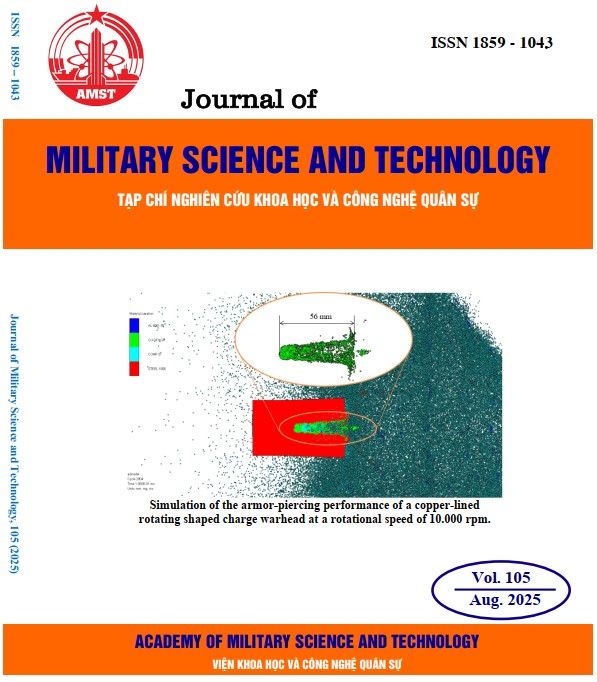Thiết kế hệ thống đo và phân tích tín hiệu ECG sử dụng thuật toán SVM trong phân loại loạn nhịp tim
303 lượt xemDOI:
https://doi.org/10.54939/1859-1043.j.mst.105.2025.36-43Từ khóa:
Học máy; Máy hỗ trợ véc-tơ SVM; Hàm cơ sở Hermite; Tín hiệu điện tâm đồ (ECG).Tóm tắt
Bài báo này trình bày một thiết bị phần cứng đề xuất để đo tín hiệu điện tâm đồ (ECG) với hệ thống từ xa tích hợp để phân tích tín hiệu tự động, giúp bác sĩ theo dõi sức khỏe và chẩn đoán các bệnh tim mạch. Thiết bị đo lường này có thể truyền tín hiệu ECG trực tuyến tới máy chủ, máy chủ này được trang bị phần mềm để phân tích và phân loại tín hiệu ECG để phát hiện loạn nhịp tim sử dụng thuật toán Support Vector Machine (SVM). Các hàm cơ sở Hermite được sử dụng để tạo các vector đặc trưng. Giải pháp đề xuất đã được kiểm thử với các tín hiệu ECG lấy từ cơ sở dữ liệu MIT-BIH (Massachusetts Institute of Technology, Boston’s Beth Israel Hospital). Bảy loại nhịp tim đã được phân loại với tỉ lệ lỗi là 5.07%. Thuật toán SVM đề xuất hoạt động rất nhanh, phù hợp với yêu cầu phân loại nhanh các bệnh tim mạch.
Tài liệu tham khảo
[1]. P.S. Hamilton and W.J. Tompkins, "Quantitative investigation of QRS detection rules using the MIT/BIH arrhythmia database", IEEE Trans. Biomed Eng., vol. BME-33, pp. 1157-1165, (1986). DOI: https://doi.org/10.1109/TBME.1986.325695
[2]. Thakor, N. V., Webster, J. G., and Tompkins, W. J, “Optimal QRS detector”. Medical and Biological Engineering, 343–50, (1983). DOI: https://doi.org/10.1007/BF02478504
[3]. R. Mark Moody, “The impact of the MIT-BIH Arrhythmia Database”, IEEE Eng. in Medicine and Biology 20(3): 45–50, (2001). DOI: https://doi.org/10.1109/51.932724
[4]. Jalal A. Nasiri, M. Naghibzadeh, “ECG Arrhythmia Classification with Support Vector Machines and Genetic Algorithm”, Third UKSim European Symposium on Computer Modeling and Simulation, (2009). DOI: https://doi.org/10.1109/EMS.2009.39
[5]. Pengfei Gao; Jingwei Zhao; Guijin Wang; Hengkai Guo, “Real time ECG characteristic point detection with randomly selected signal pair difference (RSSPD) feature and random forest classifier”, 38th Annual International Conference of the IEEE Engineering in Medicine and Biology Society (EMBC), pp. 732 - 735, (2016). DOI: https://doi.org/10.1109/EMBC.2016.7590806
[6]. Tran Hoai Linh, Pham Van Nam, “Multiple neural network integration using a binary decision tree to improve the ECG signal recognition accuracy”, International Journal of Applied Mathematics and Computer Science, vol. 24(3), pp. 647–655, (2015). DOI: https://doi.org/10.2478/amcs-2014-0047
[7]. Tran Hoai Linh, Pham Van Nam, Nguyen Duc Thao, "A hardware implementation of intelligent ECG classifier", COMPEL: The International Journal for Computation and Mathematics in Electrical and Electronic Engineering, vol. 34, Iss: 3, pp. 905 – 919, (2015). DOI: https://doi.org/10.1108/COMPEL-05-2014-0119
[8]. Patel, R., Garcia, S., Lee, C. "An IoT-based ECG Monitoring System with Real-Time QRS Detection and Alerting". Journal of Medical Engineering & Technology, (2020).
[9]. Pham, V. N., & Tran, H. L. “Electrocardiogram (ECG) circuit design and using the random forest to ECG arrhythmia classification”. In International Conference on Engineering Research and Applications (pp. 477-494). Cham: Springer International Publishing, (2022). DOI: https://doi.org/10.1007/978-3-031-22200-9_54
[10]. Nguyen Thanh Trung, Vuong Tri Tiep, Phạm Van Nam, “Application of ARM IC and ADAS1000-3 for Designing a Cardiac Electrical Measurement Device with QRS Complex Detection Function”, The International Conference and Exhibition on Control and Automation, 7th Edition -VCCA, (2024).
[11]. Alamatsaz, N., Tabatabaei, L. S., Yazdchi, M., Payan, H., Alamatsaz, N., & Nasimi, F. “A lightweight hybrid CNN-LSTM model for ECG-based arrhythmia detection”, (2022). arXiv.org. https://arxiv.org/abs/2209.00988
[12]. Roy, M. Majumder, S., Halder, A., & Biswas, U. “ECG-NET: A deep LSTM autoencoder for detecting anomalous ECG”. Engineering Applications of Artificial Intelligence, 124, 106484, (2023). https://doi.org/10.1016/j.engappai.2023.106484. DOI: https://doi.org/10.1016/j.engappai.2023.106484
[13]. Shah, H., Saeed, F., Diyan, M., Almujally, N., & Kang, J. “ECG‐TransCovNet: A hybrid transformer model for accurate arrhythmia detection using Electrocardiogram signals”. CAAI Transactions on Intelligent Technology. https://doi.org/10.1049/cit2.12293. DOI: https://doi.org/10.1049/cit2.12293







